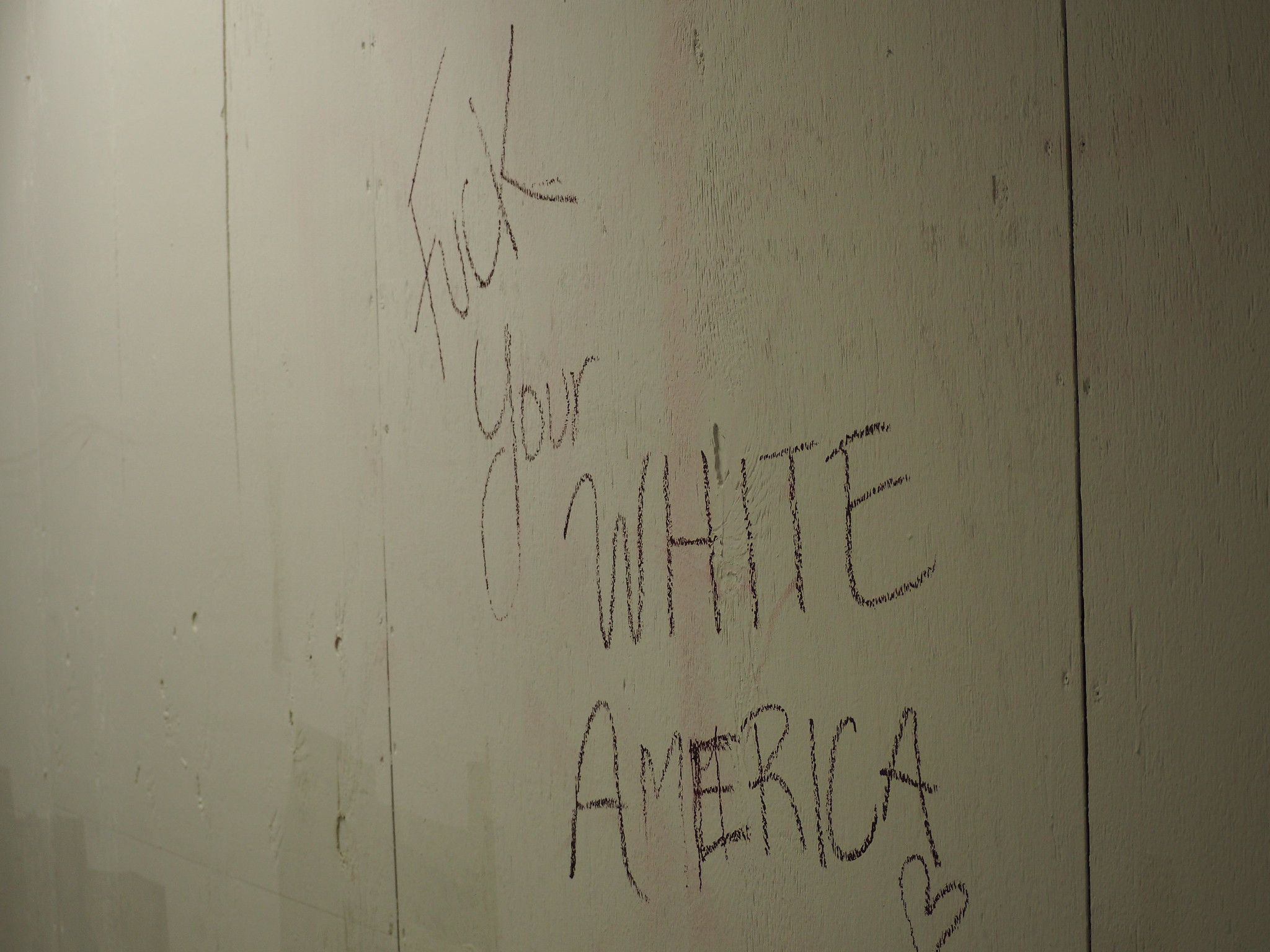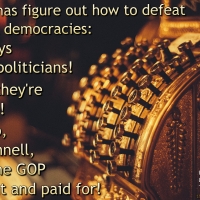Ye Olde Blogge has been bitching about the ease with which white America is duped by Repubes dog whistling their way to electoral victory, and then proceeding to fuck over their states and country. What else can you conclude when 57% of white people voted for four more years of Trump?!?
Dog whistles work because they resonate with the racism that is at the core of America’s deep culture. There is no escaping it. We are all touched by that racism. It is in our national DNA.
When GQP political candidates begin pissing and moaning about CRT, mythical rising crime rates, and #AllLivesMatter or #BluesLivesMatter, they are whistling themselves up some racial animus in suburban white voters who fear themselves burglaring, murdering, raping black masses being handed the American dream destroying all their hard earned privilege. It makes them mad.
Ye Olde Blogge has lamented that racism wasn’t diminishing in the United Fucking States of Fucking Stupid as we had presumed, but it was just hiding under the fridge waiting for lights to go out. It turns out that that thesis is both right and wrong… or at least there is some glimmer of hope creeping into our storm darkened sky like the sun shining round the shadow of the moon during an eclipse ready to blind us if we look to directly at it.
As it turns out parsing the decades of data coming out of the Project Implicit the amount of implicit racial bias expressed by participants diminished between 2007 and 2016.
If you are unprepared to encounter interpretations that you might find objectionable, please do not proceed further.
Project Implicit
That’s the glimmer of hope: the amount of implicit racial bias animating the actions of the participants diminished. The rocks that the hope crashes upon are the likely causes of the diminution of the racial bias. We’ll explain, but first a word about implicit bias.
Implicit Bias
The Implicit Association Test (IAT) measures attitudes and beliefs that people may be unwilling or unable to report. People are often unwilling to reveal socially undesirable beliefs or actions, like racism or sexual harassment. Everybody knows these things are wrong, so we are careful-ish about when, where, how, and to whom we reveal these things. It’s why open mic gafs are so important because they reveal the true beliefs that public figures keep hidden from the public.
Sometimes people just aren’t paying close enough attention to what they believe or do to be able to actually cover it up. I’m not racist! I have a BLACK friend! I VOTED for Obama! but the speaker won’t sit next to a BLACK person on a city bus, getting up and moving without ever realizing that that is what they’re doing. You know, that kind of thing.
I don’t mind Blacks knowing about Black history, but we shouldn’t teach it in a way that makes white students (read that as me) uncomfortable. That kind of tone deafness makes the perpetrator unaware of their own bias and racist behavior.
How does the IAT Work?
The IAT asks participants to push one of two buttons depending on instructions and the picture flashed onto the screen. Two ideas are represented by each button. For example, the left-hand button is assigned to women AND science while the right-hand button is assigned to men AND housework. The more closely associated the two items are the more quickly you can push the button when a picture representing either one is flashed on the screen.
The test is divided into a series of sets so that each of the two sets of variables are paired and each gets equal time with either hand. The order of those pairings and handed responses is randomly distributed among all participants.
In addition to the implicit data, they ask respondents for their explicit attitudes on the attitude the IAT is evaluating.
I like this warning that they’ve added: If you are unprepared to encounter interpretations that you might find objectionable, please do not proceed further. That’s funny.
Patterns of Implicit and Explicit Attitudes
In the decade of 2007 to 2016, Project Implicit gathered some 20 million test results across 14 attitudes, not just race. These researchers analyzed 4 million of those test results concerning six attitudes (sexuality, race, skin tone, age, disability, body weight). They used some boring and difficult to understand statistical analysis to control for changes over time and the lack of representativeness of the sample. For example, the sample has become less female, less young, more White, more liberal, and more educated as time went on, so they weighted the responses. However, the racial and educational attainment of the sample approximated that of the US based on US Census data, but the sample was younger, more liberal and more liberal than the US population, so they weighted those variables, too.
Okay that wasn’t difficult to understand, but still it was a little boring. There’s no snarky, sarcasticky, or profaney of putting it, though. No wonder so few really likes science.
Changes in Implicit and Explicit Racial Attitudes
Over the decade studied, they found that explicit race attitudes became more neutral by approximately 37% and implicit race attitudes by 17%. What’s interesting, though, is that the change was not on a constant downward trajectory. It had been fairly steady from the year seven until the year twelve, and then a big decline occurred. Hunh. Go figure. What coulda happened? More on interpreting the findings in a minute, but let’s look at what else they found.
They determined was that changes in implicit racial attitudes predicted the changes to the explicit ones by one to six months. Implicit attitudes seemed to cause explicit attitudes to change.
The stability of the explicit and implicit views differed by generation with Baby Boomers (1945–1963) and Gen X’ers (1964–1975) having relative stable views over the decade, but Millennials (1976–1995) moving toward neutrality. There weren’t enough data from Gen Z (1996–2009) and the Silent Generation (pre-1945) to make calculations with.
Factors Influencing Change
Social psychologists have been interested in attitudes and the factors that cause them to change for some time. Mostly, they’ve studied explicit attitudes, though. Few have addressed implicit attitudes and changes. The predominant theory on changing explicit attitudes goes like this:
There are three factors that predict resistance to changing explicit attitudes:
- High overall bias
- Strong intra-attitudinal linkages: These are correlations between attitudinal measures you know like the correlation between forced birth, Second Amendment rights, strong borders, and racism.
- Low priority by society, meaning that the attitude-holder doesn’t perceive that the overall society doesn’t prioritize a particular attitude. If it did, it would be occurring frequently in discussions and in media.
As the attitudes that society values change, explicit expressions of those attitudes change. We’ve seen this with racial attitudes, and it led to that false sense of security that racial animus was declining and we might could finally see the end of racism in our country.
Because culture is more stable and slow to change, implicit attitudes will be more stable and slow to change.
Interpreting the Data
What to make of the pattern of changes that were seen in the data? There were three that were interesting:
- Explicit bias moved toward neutrality about twice the rate as implicit bias (37% versus 17%)
- Attitudes were stable until 2012 and then big change happened from 2012 to 2016
- The changes were driven by changes to the attitudes of Millenials (1976 – 1995).
The difference between change between the two types of attitudes suggests that those with strong implicit attitudes about race are not the same as those with strong explicit attitudes and vice versa. The correlation between the two weakened over time.
Of course, one explanation for the faster decline in explicit racial bias is social desirability bias. People will deny their responses that they perceive as being less socially desirable. There are two factors that support this interpretation.
First, the big changes occurred post 2012. What happened in 2012? Our first Black president won a second term. During his first term, there was a lot of racist “jokes” and cartoons passed around about him and the First Family. His second term would be the pinnacle of anti-racial attitudes being clearly and frequently expressed by various social agents like in the media with mixed race couples in commercials, Black actors getting more prominent roles, racism playing greater roles in TV shows and movies, anti-racists rising to prominence and getting air time. It was a time when societal views of racism were explicitly running towards equality.
Millennials led the charge. By 2012, they were 17 – 36 years old, meaning that they were the first generation to be raised under the old civil rights regime, meaning seeing growing equality in voting and across society for Blacks and SCOTUS gutting the Voting Rights Act in 2013. Civil rights, racism, and systemic racism were the themes of their life, and it all came to a head during Obama’s presidency.
Any Millennial with explicit racial animus beating in their soul knew better than to say so out loud, and many more had diminished levels of racial bias handed down to them from their parents and society in general. The predictive value of implicit bias strongly suggests that this interpretation is correct.
Applying the Findings
The role of perceived societal priority of attitudes is why we don’t tell racist jokes and remove statues honoring racists. It would be interesting to see the analysis of the data from 2017 to present to see if the trend continues, but somehow I don’t think it will. Racism has become acceptable again. The perceived societal priority has declined. The correlations with other attitudes have strengthened. And overall racial bias has increased.
One of the clearest examples of the acceptability of racism comes from France where the far-right is revisiting the antisemetic Dreyfus affair. Who woulda thunk that?
It is why it is important to continue with high profile anti-racist activities like reassessing our roadside historical markers for their racist content. It is why we need to show up to school board meetings to push back against the strawman of CRT and run for those local positions to prevent our local politics from being dominated by MAGA Nation’s racism.
This study strongly suggests that both explicit and implicit attitudes respond to environmental and social factors. That the pendulum had swung against racial bias during the decade from 2007 to 2016 means that it could be swinging back the other way unless we take clear and open steps to prevent it.

Leave a COMMENT!
This post begs for a comment, so consider:
- Did you take a Project Implicit IAT? If so, which one, how’d it turn out?
- What do you think of the IAT? Is it accurate?
- Do you think that by emphasizing racial equality in our media and itneractions, we can really change biases?
- Why do you think we’re seeing a resurgence of racial bias?
Otherwise, like or rate the post or share it on your social media!
You can always join the email list or follow the blog!
Image Attribution
“Leading the charge” by Jpimentel1182 is licensed under CC BY 2.0
Categories: Racism, Social Psychology






















Reblogged this on cabbagesandkings524 and commented:
Calico Jack finds a very interesting study on racial bias.
LikeLiked by 1 person
One thing certain is that at whatever levels and geographic areas the GOP holds or gains effective control, they will seek to halt or reverse the removal or contextualization of public monuments celebrating racist figures, and to to remove or downgrade ones that function as markers of neutrality.
I’ve lost track of the generational breakdown of MAGA Nation and the Jan6 rioters. I’ll bet there is a correspondence with the generational pattern here.
LikeLiked by 1 person
Howdy Bob!
The interesting thing about MAGA Nation and the insurrectionists is that they are largely middle class and gainfully employed. There are no arguments to be made that any of their behavior is driven by economic angst. I think it still skews towards older, which means that few of Gen X and Gen Z are supporters, but many Millennials are.
The thing that is really interesting and requires much more research is the difference between implicit and explicit bias. There were a substantial number of respondents claiming to have lower explicit bias than had lower implicit bias. You’d always expect this to be true just because of social desirability bias, but here it suggests that there is ground for MAGA to recruit from Gen X. When people are desperate, they’ll turn to authoritarianism, especially if they perceive some benefit in it for them. They’ll be splitting us along racial lines.
Huzzah!
Jack
LikeLiked by 1 person
Splitting along racial lines is the SOP of the GOP. We can always count on that.
LikeLiked by 1 person